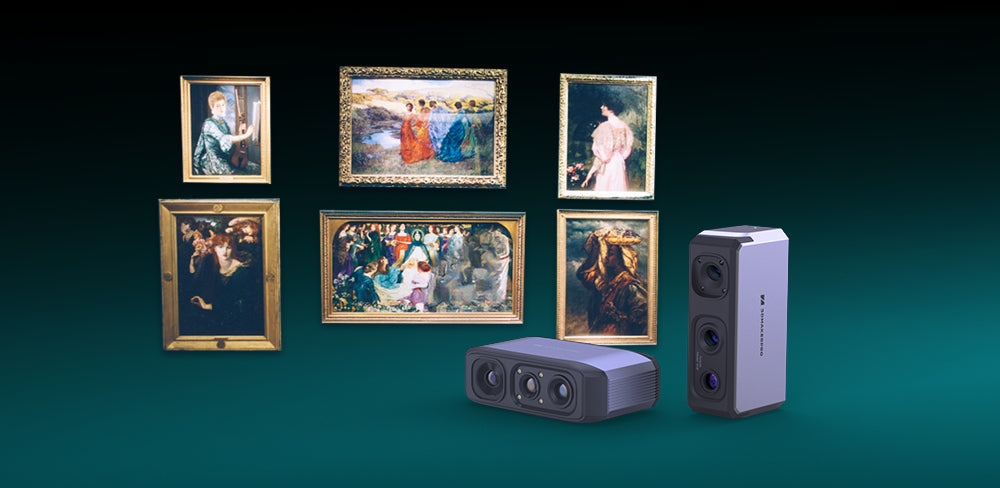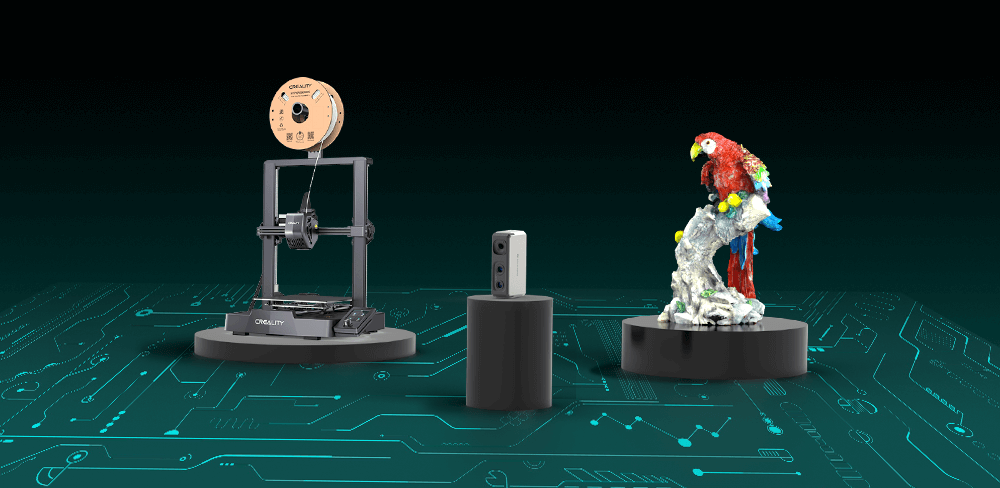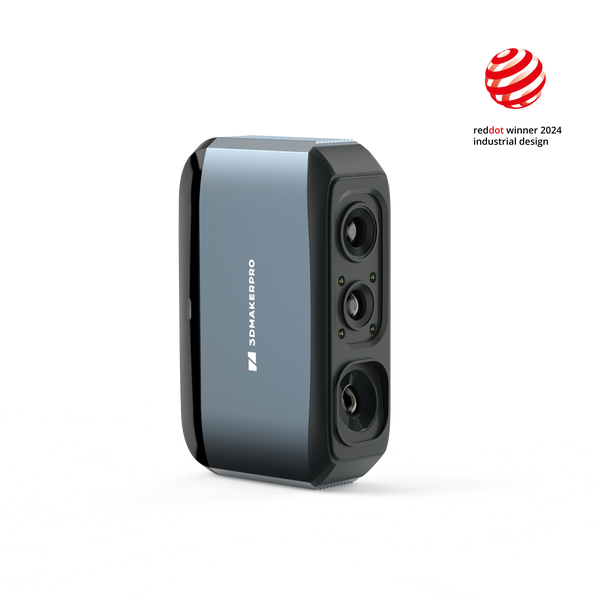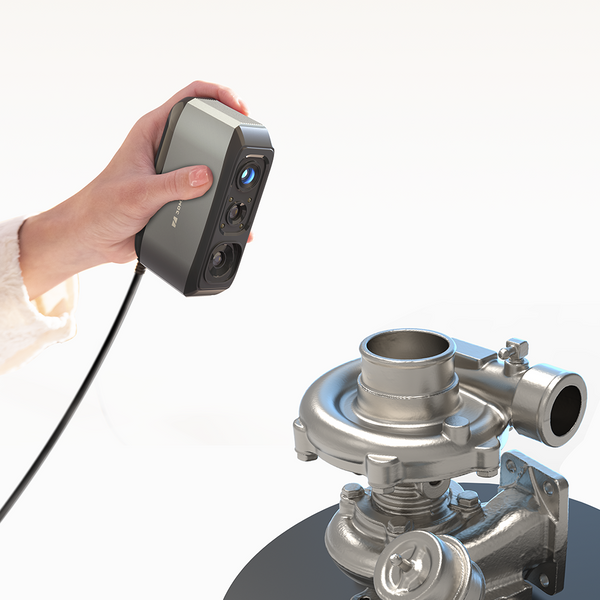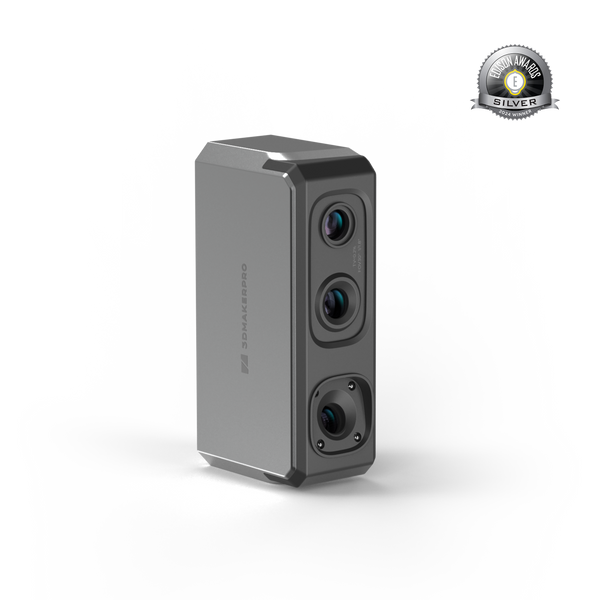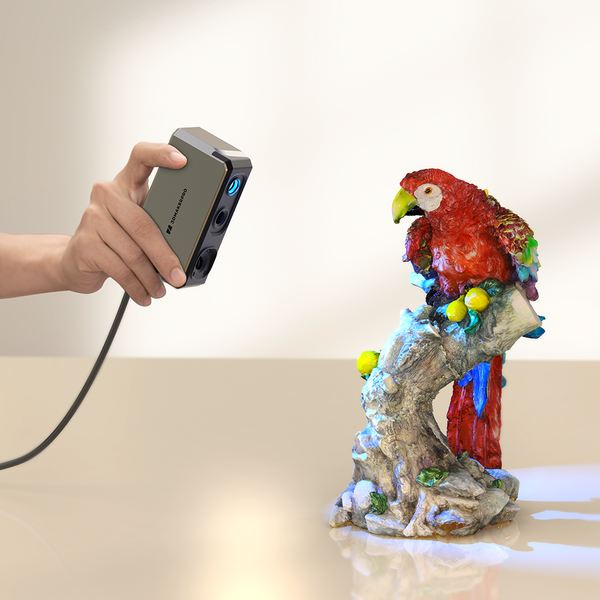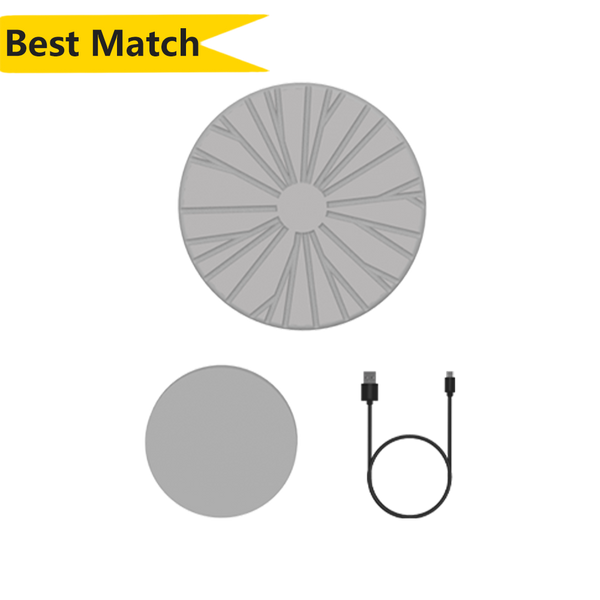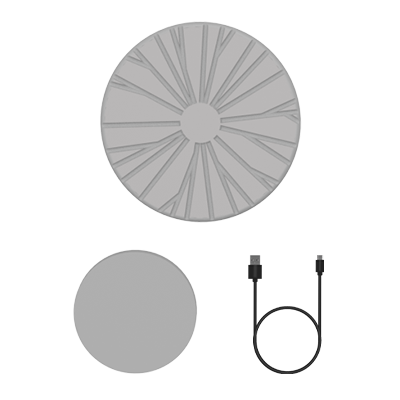In der sich entwickelnden Welt der digitalen Kreativität setzen Künstler, Designer und Entwickler zunehmend auf 3D-Scanning, um die Lücke zwischen der physischen und virtuellen Welt zu schließen. Werkzeuge wie das 3DMakerpro Elch- und Robbenscanner bieten unübertroffene Präzision und Benutzerfreundlichkeit und sind daher unverzichtbar für alle, die künstlerische Projekte verwirklichen oder verbessern möchten. Ob Sie eine Figur für ein Spiel modellieren, eine interaktive Galerieinstallation erstellen oder ein Modell für den 3D-Druck vorbereiten – das Verständnis des 3D-Scannens eines Objekts ist heute eine grundlegende Fähigkeit in modernen kreativen Arbeitsabläufen.
Von photogrammetrischem 3D-Scannen bis hin zur strukturierten Lichttechnologie untersucht dieser Leitfaden, wie 3D-Scannen und -Drucken künstlerische Praktiken neu gestalten – und wie Sie die richtigen Werkzeuge wie 3D-Scan-Spray, Software und Hardware für Ihr Projekt auswählen.
Die Schnittstelle von Kunst und Technologie: 3D-Scanning im kreativen Bereich
Digitale Kunst hat sich weit über Pixel auf einem Bildschirm hinaus entwickelt. Kreative nutzen heute Werkzeuge wie strukturierte Lichtscanner und Photogrammetrie-Apps, um Skulpturen, Umgebungen und sogar Performances in detaillierte 3D-Daten umzuwandeln.
Doch wie gelangt man von einem physischen Objekt zu einem 3D-druckbaren oder animierbaren Modell? Der Prozess beginnt mit dem Verständnis der Methoden des 3D-Scannens.
So scannen Sie ein Objekt in 3D: Die Grundlagen
Im Kern geht es beim 3D-Scannen darum, die Form und manchmal auch die Farbe eines realen Objekts zu erfassen und in ein digitales 3D-Modell zu übertragen – typischerweise als Mesh-Datei im STL-, OBJ- oder PLY-Format. Dieses Mesh kann dann bearbeitet, animiert oder an einen 3D-Drucker gesendet werden.
Es gibt mehrere gängige Methoden:
Photogrammetrie: Verwendet mehrere Bilder einer Standardkamera oder eines Smartphones. Ideal für die Erfassung realistischer Farben und Texturen, kann jedoch Probleme mit der Maßstabsgenauigkeit oder reflektierenden Oberflächen haben.
Strukturiertes Lichtscannen: Projiziert ein Raster oder Lichtmuster auf eine Oberfläche und erfasst Verformungen, um die Form zu verstehen. Diese Technik bietet hohe Genauigkeit und Auflösung – ideal für Künstler, Designer und Ingenieure.
Tiefensensor- und LiDAR-Kameras: Diese sind in einige Smartphones und Tablets (z. B. iPhone Pro-Serie) integriert und bieten eine schnelle Möglichkeit zum Scannen unterwegs, sind jedoch weniger präzise als dedizierte Scanner.
Für professionelle Kreative und diejenigen, die 3D-Modelle für den Druck erstellen möchten, sind Strukturlichtscanner wie Elch- und Robbenserie von 3DMakerpro bieten einen erheblichen Vorteil hinsichtlich Scanqualität und Benutzerfreundlichkeit.
Auswahl zwischen Photogrammetrie und 3D-Scanning
Obwohl Photogrammetrie oft leichter zugänglich ist, insbesondere für Einsteiger, bringt sie auch Einschränkungen mit sich. Lichtschwankungen, reflektierende Oberflächen und lange Verarbeitungszeiten können die Zuverlässigkeit für kommerzielle oder druckreife Projekte beeinträchtigen.
Tragbare 3D-Scanner hingegen bieten Feedback in Echtzeit, präzise Messungen und reibungslosere Arbeitsabläufe.
Strukturlicht-Scanning bietet ein Maß an Präzision und Vielseitigkeit, das die Photogrammetrie nicht durchgehend bieten kann – insbesondere, wenn Genauigkeit und Geschwindigkeit entscheidend sind. Zum Beispiel die Seal 3D-Scanner von 3DMakerpro bietet eine Genauigkeit von 0,01 mm und eine 24-Bit-Farberfassung und ist somit ideal für Künstler, die sowohl Form als auch visuelle Textur bewahren möchten.
Wann wird 3D-Scan-Spray verwendet?
Ein Problem, mit dem alle Scanmethoden konfrontiert sind, ist der Umgang mit schwierigen Oberflächen – wie transparenten, glänzenden oder dunklen Materialien.
Dort 3D-Scanning-Spray kommt ins Spiel. Diese matten Beschichtungen erzeugen eine einheitliche Oberfläche, die Scanner präzise erfassen können. Beim Scannen von Glas-Skulpturen, Kunstwerken aus schwarzem Kunstharz oder metallischen Installationen kann die Anwendung eines Scan-Sprays wie dem von 3DMakerpro die Ergebnisse deutlich verbessern.
Vom Scan zum Druck: 3D-Scannen und -Drucken in der Kunstwelt
Was passiert als Nächstes, nachdem Sie Ihren Scan erfasst haben?
Künstler können 3D-Modellierungssoftware wie Blender, ZBrush oder Geomagic Wrap (auch über 3DMakerpro verfügbar), um ihr Netz zu verfeinern, Details hinzuzufügen oder Unvollkommenheiten zu beseitigen.
- Dieses Modell kann dann sein:
- Für den 3D-Druck exportiert (z. B. STL für FDM- oder Harzdrucker)
- In VR/AR-Umgebungen importiert
- Wird in der Spieleentwicklung oder Animation verwendet
- Gerendert für digitale Ausstellungen oder Galerieinstallationen
Digitalkünstler haben gescannte Modelle in interaktive VR-Skulpturen, Projektionsinstallationen und digitale Doubles für Performancekunst verwandelt. Doch das Potenzial von 3D-Scanning und -Druck in der Kunstwelt wächst stetig – an der Schnittstelle von physischem Handwerk und digitaler Innovation entstehen neue kreative Möglichkeiten.
Neue Medien erschließen: Skulptur, Installation und digitale Fertigung
3D-Scanning ermöglicht es Künstlern, handgeformte Tonmodelle, Fundstücke oder sogar ganze Architekturelemente mit beeindruckender Genauigkeit zu digitalisieren. Diese Scans können anschließend skaliert, modifiziert und mittels additiver Fertigung reproduziert werden. So können Künstler mit Form, Textur und Wiederholung experimentieren, ohne die Einschränkungen traditioneller Materialien.
So kann beispielsweise ein Keramiker sein Original scannen und daraus eine leichte Replik aus Kunstharz für die Außenausstellung erstellen. Ein Performancekünstler könnte seinen eigenen Körper scannen, um tragbare 3D-gedruckte Prothesen herzustellen, die die Grenze zwischen Identität und Design verwischen. Diese hybriden Arbeitsabläufe sind in der zeitgenössischen Kunstpraxis immer häufiger anzutreffen, wo digitale Fertigung mit konzeptioneller Auseinandersetzung einhergeht.
Erhaltung und Archivierung von Kulturgütern
Museen und Galerien nutzen mittlerweile 3D-Scans, um empfindliche Artefakte und Kunstwerke digital zu konservieren. Durch hochauflösende Scans von Skulpturen, Gemälden oder Installationen können Institutionen präzise Repliken für spätere Studien, Restaurierungen oder digitale Ausstellungen archivieren. Dies ist besonders wertvoll in der Konservierung, wo der physische Kontakt minimiert werden muss.
Mit Werkzeugen wie dem 3DMakerpro-SiegelMit einer Genauigkeit von 0,01 mm können Kultureinrichtungen selbst feinste Oberflächenstrukturen, Inschriften oder Pinselstrichdetails erfassen. Diese Scans können zur Herstellung 3D-gedruckter Replikate für Bildungsprojekte, Wanderausstellungen oder virtuelle Museumsrundgänge in VR-Umgebungen verwendet werden.
Interaktive und immersive Erlebnisse
Die Integration von 3D-Scanning in immersive Medien definiert die Art und Weise, wie sich das Publikum mit digitaler Kunst auseinandersetzt, neu. Durch das Scannen realer Objekte oder Umgebungen können Künstler lebensechte 3D-Objekte für den Einsatz in XR-Erlebnissen (Extended Reality) erstellen – einschließlich AR-, VR- und MR-Installationen.
Stellen Sie sich vor, Sie betreten eine digitale Galerie, in der jede Skulptur ursprünglich von Hand geschnitzt, dann gescannt und in einen interaktiven virtuellen Raum übertragen wurde. Oder erleben Sie eine Installation, bei der Ihr Körper in Echtzeit gescannt und in ein generatives Kunstwerk integriert wird, das sich basierend auf Ihren Bewegungen weiterentwickelt. Solche Erlebnisse sind nicht länger experimentell – sie werden bei digitalen Kunstfestivals und neuen Medienpräsentationen zum Standard.
Mode, Performance und Körperkunst
3D-Scanning sorgt auch in der tragbaren Kunst und im Performance-Design für Aufsehen. Modedesigner nutzen Körperscans, um perfekt sitzende Kleidungsstücke zu entwerfen oder avantgardistische 3D-gedruckte Accessoires zu entwickeln, die von Hand nicht hergestellt werden könnten. Choreografen und Performancekünstler erforschen Bodymapping und Motion Capture mithilfe von 3D-Scanning als Grundlage für Echtzeitprojektion oder digitale Augmentation.
Beispielsweise könnte ein Künstler seinen eigenen Oberkörper mit einem Gerät wie dem scannen Elchscanner von 3DMakerpro– ideal für mittelgroße menschliche Formen – und nutzen Sie diese Daten, um ein skulpturales Kostüm oder einen digitalen Avatar zu erstellen. Das Ergebnis ist eine nahtlose Verschmelzung von physischer Präsenz und digitaler Identität.
Bildungsanwendungen in Kunst und Design
Kunsthochschulen und -institutionen integrieren zunehmend 3D-Scanning in ihren Lehrplan und vermitteln Studierenden den Übergang zwischen physischen und digitalen Verfahren. Scan-Tools ermöglichen es Studierenden, Ideen schnell zu prototypisieren, Formen zu iterieren und Materialität durch Simulation oder physische Ausgabe zu erforschen.
Durch den Einsatz benutzerfreundlicher Scanner wie denen von 3DMakerpro – gepaart mit intuitiver Software wie JMStudio– Studierende können sich stärker auf ihre Kreativität konzentrieren und müssen sich weniger mit technischen Hürden auseinandersetzen. Gescannte Modelle können fachübergreifend genutzt werden, was die Zusammenarbeit zwischen den Fachbereichen Bildhauerei, Animation, Architektur und digitale Medien ermöglicht.
Elch vs. Robbe: Welcher 3D-Scanner ist der richtige für Künstler?
Sowohl die Elch Und Siegel Die Serien von 3DMakerpro sind hervorragende Optionen, erfüllen jedoch leicht unterschiedliche Anforderungen:
|
Besonderheit |
Elch |
Siegel |
|
Genauigkeit |
0,03 mm |
0,01mm |
|
Auflösung |
0,07 mm |
0,05 mm |
|
Objektgröße |
15–1500 mm |
10–300 mm |
|
Ideal für |
Mittelgroße Objekte, allgemeines Kunstscannen |
Kleine Objekte, Schmuck, Erfassung feiner Texturen |
|
Farberfassung |
Ja (24 Bit) |
Ja (24 Bit) |
|
Portabilität |
Leichtgewicht (280 g) |
Ultraleicht (254 g) |
Für das Scannen mittelgroßer Kunstwerke, Installationen oder menschlicher Formen ist Moose eine vielseitige Wahl. Für Arbeiten mit Miniaturen, Schmuck oder komplexen Texturen ist Seal mit seiner höheren Genauigkeit und Auflösung die bessere Wahl.
Beide Scanner werden mit JMStudio-Software von 3DMakerpro, das visuelles Tracking in Echtzeit, Scannen ohne Markierungen und Export in STL, OBJ, ASC und PLY unterstützt.
Beispiel aus der Praxis: Interaktive Kunst trifft 3D-Scanning
Stellen Sie sich vor, Sie rekonstruieren ein Kandinsky-Gemälde in 3D und projizieren es anschließend mithilfe von Projektionsmapping an die Wände einer Galerie – so können Besucher in Echtzeit mit dem Werk interagieren. Genau dieses Erlebnis schaffen Künstler mit 3D-Scans und digitaler Projektion. Durch die Integration gescannter 3D-Modelle in Unity oder Unreal Engine können Sie immersive Installationen erstellen, die auf Bewegung, Geräusche oder Gesten reagieren und so physische Präsenz mit digitalem Ausdruck verbinden.
Zusammenfassung: Warum 3D-Scanning kreative Arbeitsabläufe neu definiert
Künstler sind heute nicht mehr auf Pinsel, Meißel oder Maus beschränkt. Mit Werkzeugen wie Elch- und Robbenscanner von 3DMakerprokönnen sie ihre Arbeit digitalisieren, bearbeiten und auf neue Weise neu erfinden – und so Türen zum 3D-Druck, zu virtuellen Ausstellungen und interaktiven Installationen öffnen.
Egal, ob Sie lernen, wie man ein Objekt für den 3D-Druck 3D-scannt, mit photogrammetrischem 3D-Scannen experimentieren oder nach dem besten Scanner für Ihr Kreativstudio suchen, die Tools sind zugänglicher als je zuvor.
Und mit 3D-Scan-Spray, intelligenter Software und intuitiver Hardware in tragbaren Formaten gab es nie einen besseren Zeitpunkt, Ihre Ideen in die dritte Dimension zu bringen.
Sind Sie bereit, Ihre Kreativität mit 3D-Scans zu steigern? Entdecken Sie Elch Und Siegel Scanner bei 3DMakerpro und beginnen Sie mit der digitalen Gestaltung Ihres nächsten Meisterwerks.


